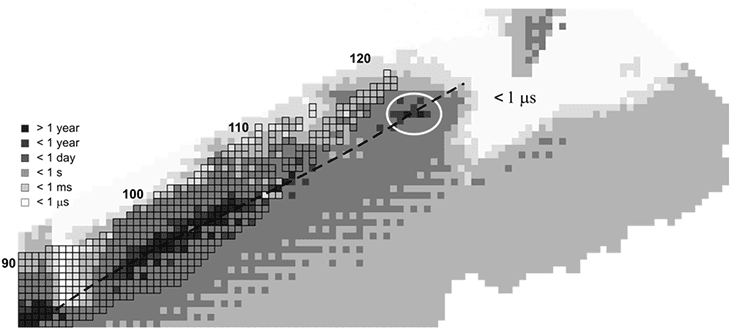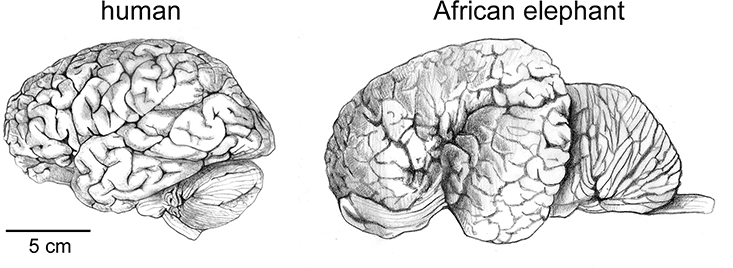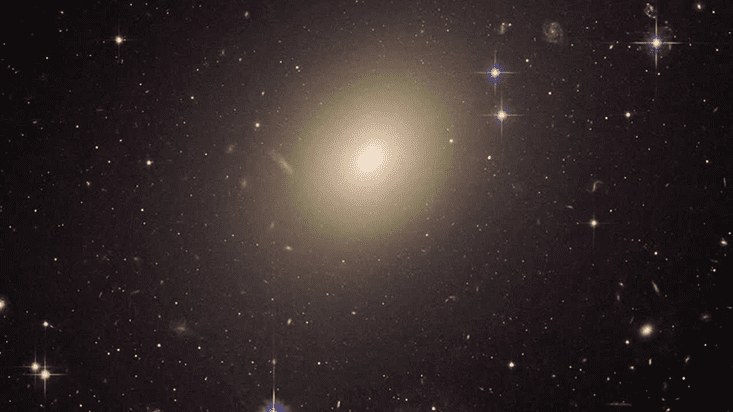We can’t help ourselves—we’re crazy about big things. We’ll venture miles out of our way to see the world’s “largest” rifle (33.3 feet long; Ishpeming, Michigan), high-heeled shoe (6.1 feet tall; New York City), or ball of twine (7.8 million feet unraveled; Cawker City, Kansas).
And for what? Spectacle aside, the largest things rarely make much sense. It’s harder, not easier, to fry a tasty egg with the largest frying pan, or drive a screw with the largest screwdriver.
In nature, too, size often comes with a cost.

The largest element is the shortest-lived
In the chemical world, scale defines identity: Add a proton to the nucleus of an atom, and a whole new element emerges. But for super-heavy elements, a very large atomic number means a very fleeting existence. Pack too many protons together, and you’ll likely find it’s impossible to make an atom at all.
Beyond uranium (92), the force that repels positively-charged protons (the Coulomb force) begins to exceed the force binding them together (the nuclear force). So as elements get heavier, they become more and more unstable. This explains why (as far as anyone knows) no elements larger than uranium occur naturally, says Christoph Duellmann, a nuclear chemist at the GSI Helmholtz Center for Heavy Ion Research and Johannes Gutenberg University Mainz, in Germany.
Scientists have artificially created heavier elements by smashing together atomic nuclei in particle accelerators. (Duellmann and his colleagues confirmed the existence of ununseptium—element 117—last year.) These atoms are short-lived, however. While the most abundant isotope of uranium has a half-life of 4.5 billion years, an isotope of einsteinium (99) has a half-life as long as 472 days. The heaviest element ever made, ununoctium (118), lasts for less than 1 millisecond.
Duellmann speculates that a theoretical element with about 170 protons or more would have a half-life of less than 1 hundred-trillionth of a second—the time it takes to create an electron shell. “Hence it is no atom,” he says.

The largest genome is the slowest to adapt
If you unraveled the DNA in a single human cell—all 3.2 billion base pairs—it would stretch 2 meters. That length, however, wouldn’t look so impressive next to the largest genome known to science, which would reach 100 meters. This 150-billion-base-pair molecule belongs to the white-flowered Japanese canopy plant Paris japonica.
Genome size varies widely among species, and it’s largely a mystery why some organisms evolved larger genomes than others. “There is no relationship between genome size and organism complexity,” says T. Ryan Gregory, an evolutionary biologist at the University of Guelph, in Canada. “There are grasshoppers with five times more DNA than humans.” Even some single-celled protists have genomes much larger than ours.
Such outsized genomes grow by accumulating non-coding, or “junk,” DNA through copying mistakes during reproduction or when offspring inherit more than one set of a parent’s chromosomes. The latter condition, known as polyploidy, is common among plants, which may explain why they have some of the largest genomes found in nature. Most animal genomes are smaller than 5 billion base pairs. The genomes of flowering plants, meanwhile, average about 6 billion base pairs, while those of non-flowering plants average about 18 billion.
Big genomes come with big disadvantages, says Ilia Leitch, a plant geneticist at the United Kingdom’s Royal Botanic Gardens, Kew, who headed the team that measured Paris japonica’s genome in 2010. Larger genomes take longer to copy, slowing an organism’s rate of growth, reproduction, and ultimately adaptation. For example, in Arabidopsis species (tiny relatives of mustard plants), which have genomes of around 135 million base pairs, reproductive cell division takes about 33 hours. In Paris japonica, Leitch estimates, this process takes six to eight weeks.
Larger genomes also require larger cells to hold all that genetic material. The size difference may be slight, but it can significantly impact cellular processes. In animals, for instance, larger blood cells are less efficient at delivering oxygen. That’s why animals with high metabolisms, such as birds and bats, tend to have especially small genomes, Gregory says.

The largest brain isn’t the smartest
The sperm whale brain tops the size charts at 20 pounds, about six times larger than our 3-pound one. And that’s about the limit when it comes to mass. Brains can’t grow much larger because the weight would begin cutting off blood flow to the arteries that feed into it.
For non-primates, this size ceiling also puts a cap on intelligence because it limits the number of neurons—and hence neural connections—that can be packed into the cerebral cortex, the region responsible for higher brain function. According to studies led by Suzana Herculano-Houzel, a neuroscientist at the Federal University of Rio de Janeiro, bigger non-primate brains also tend to have bigger individual neurons, reducing the benefit of size. While the average mass of a cerebral mouse neuron is about 8 billionths of a gram, for instance, the equivalent elephant neuron weighs in around 181 billionths of a gram.
In primates, however, evolution bucked this trend. By housing smaller neurons weighing about 30 billionths of a gram—somewhere “between a rat and a rabbit,” Herculano-Houzel says—the primate cortex can cram more neurons into a smaller space. The human cerebral cortex has about 16 billion neurons—more than any other animal—giving us a clear cognitive advantage. By comparison, an elephant’s cerebral cortex is twice as massive as a human’s, but it has only one-third as many neurons.

The world’s largest organism is becoming infertile
At 6,600 tons, the biggest living organism by mass is about 33 times larger than the leviathan of the sea, the blue whale, and about three times larger than the towering land giant, the sequoia. Pando, also known as the Trembling Giant, is a genetically identical colony of a single quaking aspen that has spread slowly in Utah over tens of thousands of years. Its 47,000 trunks share a common root system, from which it sprouts new clones.
This growth scheme allows Pando to avoid factors that usually limit size in single-stem plants, including the ability to lift water to great heights, says Michael Grant, an ecologist and evolutionary biologist at the University of Colorado Boulder. In theory, Pando could keep growing indefinitely. And so far, it has thrived with just the right amount of wildfires, mudslides, and avalanches, which have kept taller competitors at bay.
But Pando isn’t immune to the ravages of time, and its great age—which has enabled its great size—may be its Achilles’ heel. DNA studies show that aspen colonies accumulate genetic mutations as they get older, impairing their production of pollen. Without pollen, the colony would not be able to reproduce sexually, reducing the diversity of its gene pool, and making it less robust in the face of disease or climate change.

The largest galaxy is birthing fewer and fewer stars1
The Milky Way, with its hundreds of billions of stars, is a drop in a bucket compared to IC 1101, the largest known galaxy in the universe. Thought to contain around 100 trillion stars, this elliptical giant spans 6 million light-years, 60 times the diameter of our own Milky Way.
Such super-giant galaxies are rare, elderly specimens—home to mostly old stars formed when the nearly 14-billion-year-old universe was still young. How they got so big is unknown, says Richard Bower, a cosmologist at the University of Durham, in the U.K. Some might have collided with like-sized galaxies and merged together. Others might have cannibalized their smaller galactic neighbors.
Young galaxies grow by birthing new stars, formed when clouds of dust and gas collapse under their own gravitational pull into hot, dense cores. But as galaxies age and expand, star formation slows, Bower says. When galaxies become just slightly more massive than the Milky Way, the black holes at their centers become active, shooting high-energy jets. These powerful winds drive out gasses that give rise to stars, slowly draining a galaxy of star-making matter.
As the universe expands, super-giant galaxies such as IC 1101 may continue to grow through mergers and acquisitions. But the rate of growth will get slower and slower as the ingredients for stars get used up and galaxies drift apart. “Because the observable universe is a finite size, there is a limit on the biggest galaxy we’re going to see,” Bower says. “We’ve probably seen it already.”
Jeremy Hsu is a science and technology journalist based in NYC. He currently writes for publications such as Scientific American, Popular Science and IEEE Spectrum.



